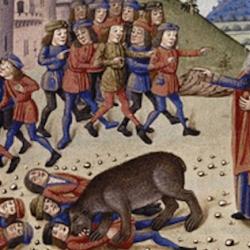Random and inconclusive notes on 2 Kings 4:8ff.
1) The woman at Shunem has a husband, in contrast to the woman at the beginning of the story who was a widow. Both, though, need Elisha as a ?father?Ewho will give birth to/save their children.
2) The Shunammite speaks of Elisha as a ?holy?Eman (4:9), and she sets him up accordingly. He lives in an upper room, with a table and a menorah and a seat/throne and a bed. Throughout the chapter, Elisha is, like Elijah, a human God ?Epeople worship him, prostrating themselves before him, and the man from Baal-shalishah actually brings his firstfruits to Elisha. Like Jesus later,
Elisha is the head of a counter-temple movement, and his installation at Shunem is the new temple. This is also consistent with the fact that Elisha deals with the Shunammite woman through a mediator, Gehazi, even when the woman is apparently present (vv. 12-13), and later Elisha is said to have an ?attendant,?Ea word built of sharat, used frequently in connection with priests (as in the phrase ?stand and serve,?EDt 18:6-7). It probably also has a connection with the fact that the woman is described as ?trembling with this trembling?Eover Elisha (v. 13). She serves Elisha in fear.
3) Obviously, when we learn that the Shunammite woman has no child and an aging husband, we know we?re back in patriarchal times. Even more, the Shunammite stands in the ?doorway?E(4:15) to hear the announcement, as Sarah did; and Elisha uses the same phrase ?at the time of living?Ein his prediction (4:16; cf. Gen 18:10). This makes the boy an Isaac, and fittingly he later dies and rises again. It also places Elisha quite clearly in the position of the angel of Yahweh who brings the announcement of birth.
4) Both the widow of the son of the prophets and the Shunammite call themselves maidservants to Elisha (4:2, 16).
5) The boy dies through a head wound, and rises again. This not only connects with the head imagery of Scripture as a whole, but more specifically with the use of head imagery in 2 Kings 2 (from off your head; bald head).
6) In this part of the passage, as with the widow, Elisha performs miracles behind closed doors. The liberation of the widows?Esons and the revival of the Shunammite?s boy are thus paralleled. Plus, in both cases, what is done in secret will be proclaimed on the housetops.
7) The Shunammite?s husband seems a bit dotty. His son has just died, and he?s wondering why his wife would be heading toward the man of God, since it?s not a festival day. (His statement implies that the Shunammite would have gone to see Elisha on festival days, another indication that he is the new, portable temple.) But he?s not dotty. He?s a realist. Boy?s dead; nothing to do about it; need to move on. The dotty one is the woman, who has the faith to believe that death is not the last word for her son.
8) When the widow approaches Elisha (the Heb uses a word that can refer to liturgical approach, and also to sexual approach), she clings to him and refuses to abandon him. Her oath is identical to the oath that Elisha himself swore in chapter 1: By the life of Yahweh and by the life of your soul, I will not forsake you. Elisha has been transformed from the one clinging to the one clung to. Curiously, though, he follows her, as he followed Elijah.
9) Everyone knows that Gehazi is unsuccessful in raising the boy. But the language of 4:31 makes this seem much worse than a lack of success. ?There was no voice, there was no attentiveness?Ecomes straight from 1 Kings 18:29, where it describes the impotence of Baal?s prophets and of Baal himself. Gehazi is certainly not a Baal-worshiper, but he appears to be compromised, as ineffective as a Baal worshiper.
10) Elisha crouches over the boy twice (vv. 34-35). The only other use of this verb in the Hebrew Bible comes from 1 Kings 18, where Elijah ?crouches?Eover the ground before the rain cloud comes.
11) Elisha raises the boy by stretching himself eye-to-eye, mouth-to-mouth, and palm-to-palm. The life that he returns to the boy consists in sight, speech, and action.
12) There is sexual imagery running through the passage. Twice the woman grabs Elisha by his ?feet,?Ea frequent sexual euphemism. I?m not saying that she grabbed Elisha by his balls; she held his feet. But the language hints at a sexual connotation. She also ?enter to?Ehim (v. 27) before she grabs his feet, and this language too can have sexual connotations (Gen 16:2). The ?birth?Eof the boy takes place on a bed. All this is not surprising since in a real sense Elisha is doubly a husband and father ?Epromising the boy in the first place, and then restoring the boy after he dies.















